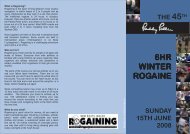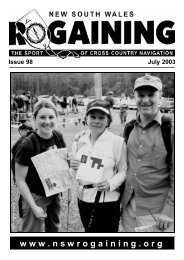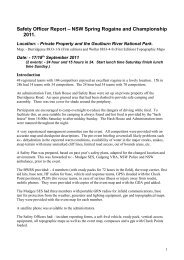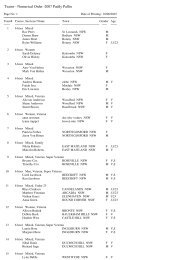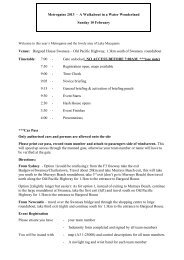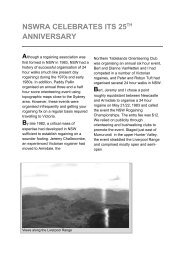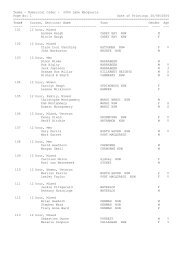VRA novice pack 2002 - NSW Rogaining Association
VRA novice pack 2002 - NSW Rogaining Association
VRA novice pack 2002 - NSW Rogaining Association
You also want an ePaper? Increase the reach of your titles
YUMPU automatically turns print PDFs into web optimized ePapers that Google loves.
Checkpoint description<br />
sheet terminology<br />
Along with the map, you also get a checkpoint description sheet that<br />
describes the location of all the checkpoints. Checkpoint descriptions<br />
begin with ‘THE’ or ‘A’. Checkpoint descriptions beginning with ‘THE’,<br />
e.g. ‘The Spur’, indicate that the spur is a feature that is recognisable<br />
on the map. Checkpoint descriptions beginning with ‘A’, e.g. ‘A Knoll’,<br />
is one that is not marked on the map but is actually there. Often ‘A’<br />
features are implied by the contour lines. Correct checkpoint<br />
description terminology is shown in Figure 2.<br />
Checkpoints may also have a checkpoint description that states<br />
a bearing and distance from the centre of a feature, e.g. ‘The<br />
road junction, 120° 20 m’. This means you must travel to the<br />
centre of the road junction, then set your compass on 120° and<br />
travel in that direction for 20 m to find the checkpoint. Note that<br />
these bearings are magnetic ones, so there is no need to allow<br />
for magnetic declination. You just set the compass to the stated<br />
bearing and go in that direction.<br />
FINAL WORDS …<br />
This document is by no means comprehensive. It is simply<br />
designed to give you some idea of the methods, equipment and<br />
navigational techniques used by many of today’s experienced<br />
rogainers. What you do with it now is up to you. As you progress<br />
in the sport, you will discover your own methods and tricks, and<br />
become a more skillful navigator. If you want more information<br />
on navigating there is an excellent reference book available.<br />
“<strong>Rogaining</strong> – Cross Country Navigation” by Neil Phillips and<br />
Rod Phillips. Third edition published 2000 by Outdoor<br />
Recreation in Australia, Melbourne.<br />
Copies may be bought through the Victorian <strong>Rogaining</strong> <strong>Association</strong><br />
at very reasonable prices and are generally available for sale at<br />
events. Also, make sure that you get a copy of the current event<br />
rules (included in this booklet) and a <strong>VRA</strong> first aid sheet.<br />
If you have any queries or questions about rogaining or<br />
navigation in general, feel free to phone a committee member<br />
(their names and phone numbers are on page 2 of your<br />
newsletter), or speak to them at an event. They are always<br />
happy to help out anyone new to the sport.<br />
If you want to practice your skills any time, the <strong>VRA</strong> has a<br />
permanent course set up in the Mt Disappointment State Forest<br />
north of Melbourne. Checkpoint description sheets and map<br />
information is available from the permanent course manager<br />
who is listed in the <strong>VRA</strong> newsletter. Why not spend a weekend<br />
with your friends at the permanent course, practising your<br />
skills The <strong>VRA</strong> also runs training days, coaching events and<br />
map skills workshops, so keep your eye on the newsletter for<br />
information on these. If you are unable to find a partner for an<br />
event you can contact the Partner Finding Service listed on page<br />
2 of the <strong>VRA</strong> newsletter.<br />
Night navigation<br />
Once you understand the major concepts relevant to daytime<br />
navigation, you can try to put them to use at night. The main<br />
difference at night is that you can only see what is immediately<br />
around you, and possibly the outline of surrounding ridges.<br />
Events are staged as close as possible to full moons to provide<br />
the maximum amount of light at night.<br />
At night, you have to pay as much attention as possible to your<br />
compass, as well as the slope of the ground under your feet and<br />
always keep reference to where you are on the map. If you lose<br />
your position at any stage it is much harder to relocate at night.<br />
Learn to recognise features in the dark, and try to use your<br />
torch as little as possible. This helps protect your night vision.<br />
We hope you enjoy your rogaining experience. However, please<br />
remember that the <strong>VRA</strong> is totally run by volunteers, so consider<br />
volunteering your services to help in some way at an event.<br />
There are plenty of rewarding tasks that need doing, and there is<br />
something for people of all ages and abilities – from organising<br />
an event, to chopping vegetables, to collecting checkpoints after<br />
the event is over. Helping is great fun and you meet lots of new<br />
people and potential partners.<br />
Finally, make sure you have fun out there,<br />
because that’s what it’s all about!<br />
Page 28 Which way’s north An introduction to <strong>Rogaining</strong> Victorian <strong>Rogaining</strong> <strong>Association</strong><br />
Victorian <strong>Rogaining</strong> <strong>Association</strong> Which way’s north An introduction to <strong>Rogaining</strong> Page 29



